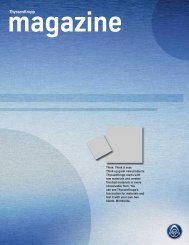Engineering
Engineering
Engineering
Create successful ePaper yourself
Turn your PDF publications into a flip-book with our unique Google optimized e-Paper software.
3.6 Consolidated financial statements Notes to the consolidated financial statements<br />
Government grants<br />
Government grants are recognized only if there is reasonable<br />
assurance that the associated conditions will be met and the grants will<br />
be received. Grants related to assets are reported as a reduction of<br />
cost of the assets concerned with a corresponding reduction of<br />
depreciation and amortization in subsequent periods. Grants related to<br />
income are stated as other operating income in the periods in which<br />
the expenses intended to be compensated by the grant are recognized.<br />
Research and development costs<br />
Research costs are expensed as incurred.<br />
Development costs, whereby research findings are applied to a plan or<br />
design for the production of new or substantially improved products<br />
and processes, are capitalized if the product or process is technically<br />
and commercially feasible, there is a market for the output of the<br />
intangible asset, the attributable expenditure can be measured reliably,<br />
and the Group has sufficient resources to complete development.<br />
Other development costs are expensed as incurred. Capitalized<br />
development costs of completed projects are stated at cost less<br />
accumulated amortization. Costs include direct costs of material, direct<br />
labour, and allocable material and manufacturing overhead. Borrowing<br />
costs directly attributable to a production of assets that necessarily<br />
takes a substantial period of time to get the assets ready for their<br />
intended use, are included in the cost of those assets until the assets<br />
are ready for their intended use. Administrative costs are capitalized<br />
only if such costs are directly related to production. Capitalized<br />
development costs of projects not yet completed are reviewed for<br />
impairment annually or more frequently when an indicator of<br />
impairment arises during the reporting year.<br />
Earnings per share<br />
Basic earnings per share amounts are calculated by dividing net<br />
income/(loss) attributable to ThyssenKrupp AG’s shareholders by the<br />
weighted average number of shares outstanding. Shares sold during<br />
the period and shares reacquired during the period are weighted for<br />
the portion of the period that they were outstanding. There were no<br />
dilutive securities in the periods presented.<br />
Consolidated financial statements<br />
142 | 143<br />
Segment reporting<br />
In accordance with the so-called management approach, segment<br />
reporting of the ThyssenKrupp Group is based on the internal<br />
organizational and reporting structure. The data used to determine the<br />
internal key figures are derived from the IFRS consolidated financial<br />
statements.<br />
Single assets held for sale, disposal groups and discontinued<br />
operations<br />
A single non-current asset is classified as held for sale if its carrying<br />
amount will be recovered principally through a sale transaction rather<br />
than through continuing use. The Group reports assets and liabilities<br />
as a disposal group, that will be disposed of by sale or otherwise in a<br />
single transaction, which collectively meet the held for sale criteria as<br />
specified in IFRS 5 “Non-current Assets Held for Sale and Discontinued<br />
Operations”. The Group reports the assets and liabilities of a disposal<br />
group separately in the balance sheet line item “assets held for<br />
sale/disposal” and “liabilities associated with assets held for<br />
sale/disposal”, respectively. Unless a disposal group qualifies for<br />
discontinued operations reporting, the revenues and expenses of the<br />
disposal group remain within continuing operations until the date of<br />
disposal. The Group reports the results of a disposal group that also<br />
qualifies as a component of the Group as discontinued operations if it<br />
represents a separate major line of business or geographical area of<br />
operations. The Group reports the results of discontinued operations in<br />
the period in which they occur separately within the consolidated<br />
statement of income as “discontinued operations (net of tax)”. All prior<br />
period consolidated statements of income are adjusted to report the<br />
results of the component within discontinued operations. In the<br />
consolidated statement of cash flows the cash flows resulting from<br />
discontinued operations are presented separately from cash flows<br />
resulting from continuing operations; prior year presentation has been<br />
adjusted accordingly. In order to present the proportion of income/loss<br />
attributable to discontinued operations, net sales and expenses arising<br />
from intercompany transactions are eliminated provided that these<br />
transactions will not continue after the disposal of the discontinued<br />
operations.

















